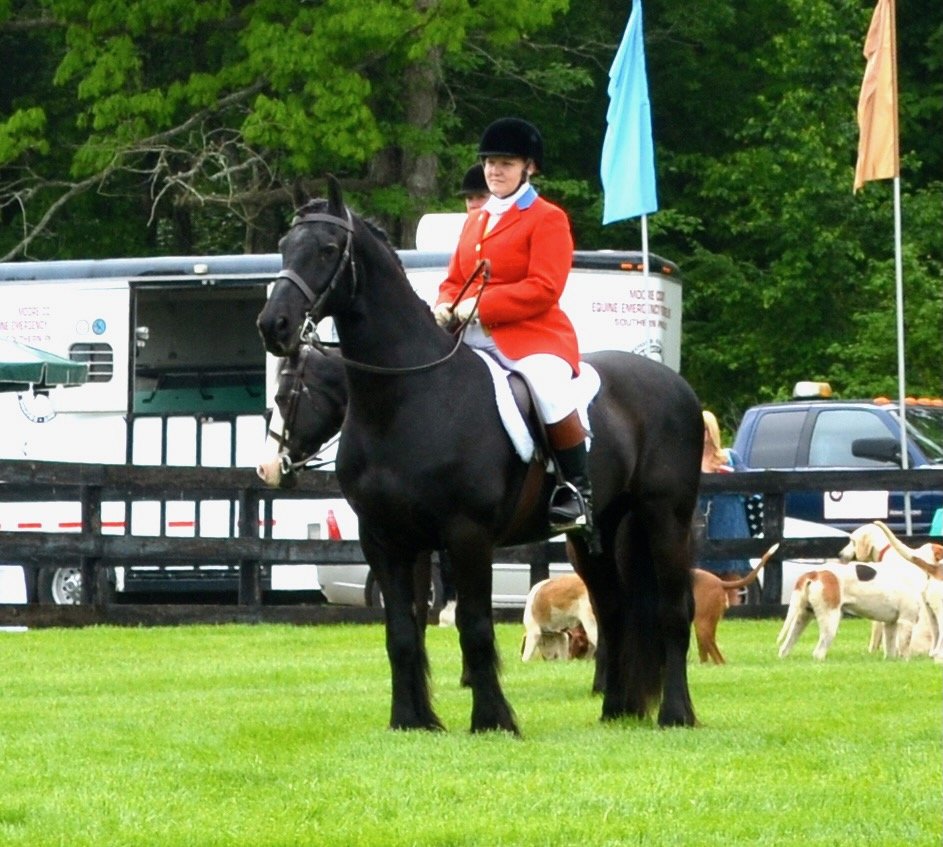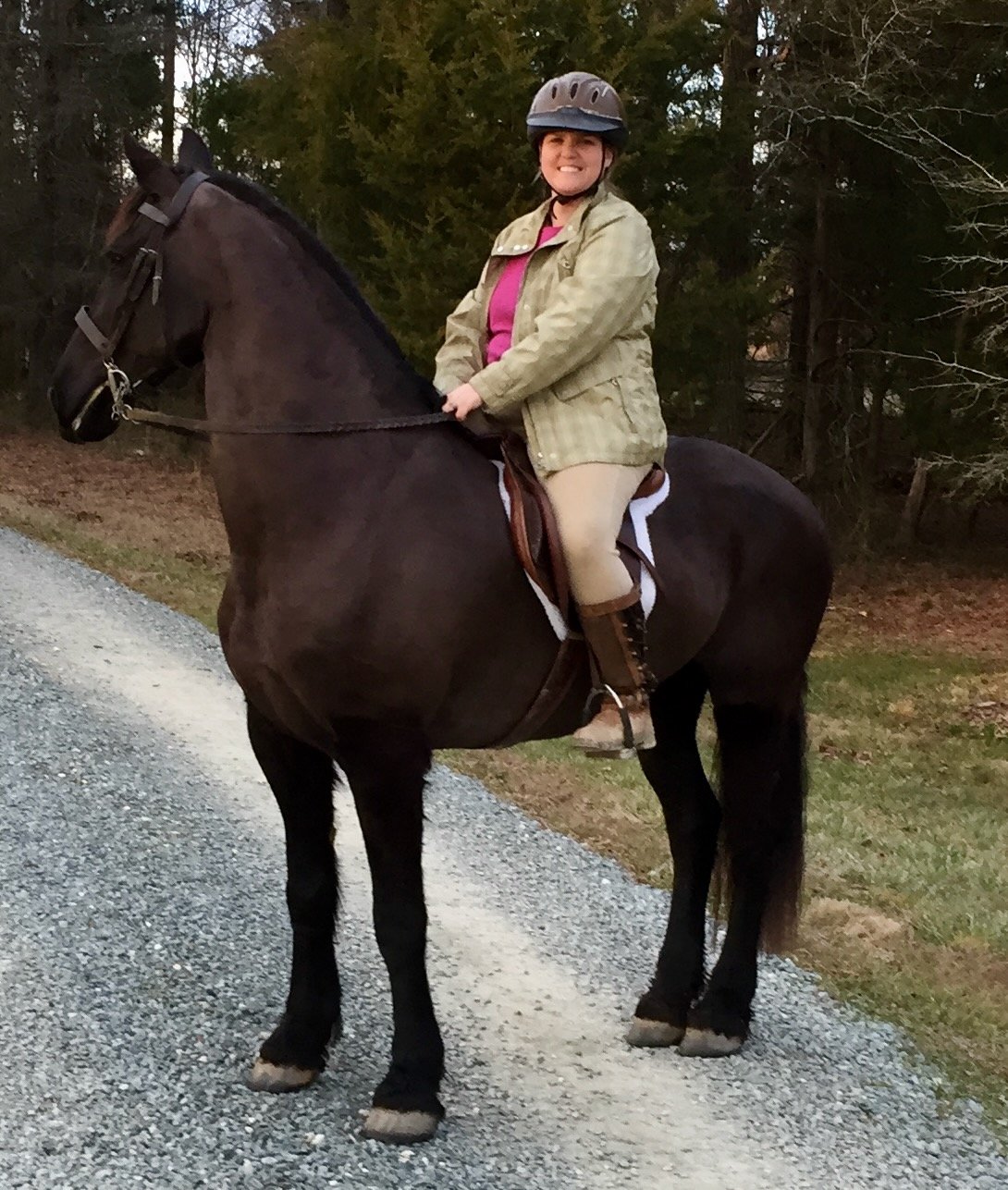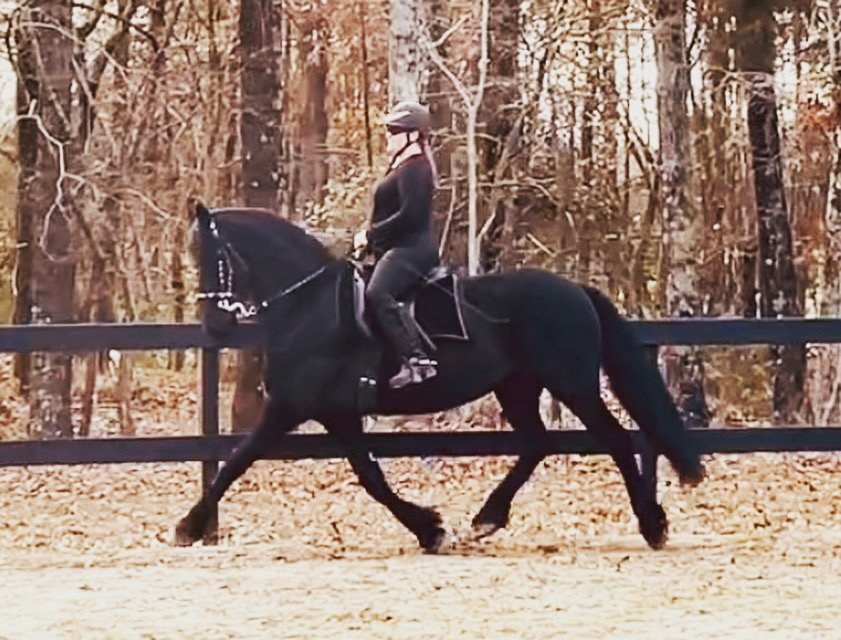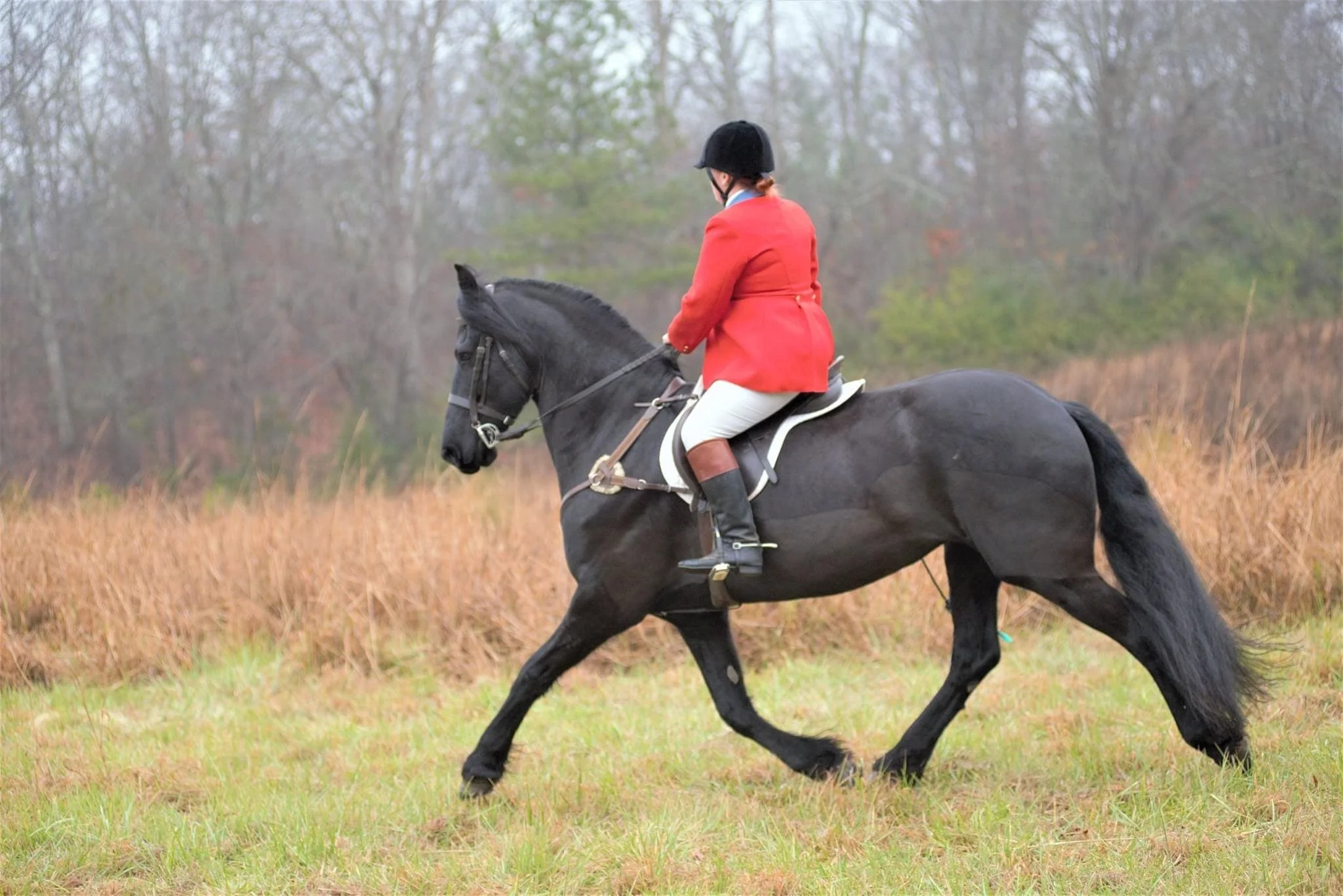Friesians
The Friesian Horse is one of the oldest Northern European breeds in the world. The Friesian horse was in danger in the mid 1900s of becoming extinct. Luckily, the Koninklijke Vereniging "Het Friesch Paarden-Stamboek" (KFPS) saved the breed. According to the KFPS (2015):
The KFPS is the oldest studbook in the Netherlands and promotes the interests of the Friesian horse in the broadest sense of the word. The KFPS has been realizing this by the meticulous registration of Friesian horses since the time it was founded in 1879. In addition, the KFPS has established a breeding program to maintain and further refine the unique characteristics of the Friesian horse.
The KFPS Friesian Horse is the most beautiful, versatile, athletic, kind, and willing horse that is able to do anything when trained properly. Many people ask if Friesians can jump. Yes they can jump, though like other breeds some are better at it than others. The Friesian is a fantasy horse as seen in many movies, such as Conan the Barbarian, Eragon, The Mask of Zorro, Alexander, The Chronicles of Narnia, Clash of the Titans and The Hunger Games. With its solid black color, symbolic of power, its strong hind quarters, coupled with its luxurious hair, the Friesian is a Fairy Tale horse. For more information please visit: www.kfps.nl
CREK Kismet
16.2hh FHANA KFPS 3rd Premium Friesian Mare
TEADE 392 SPORT X REITSE 272 SPORT PREF
Color: EE aa
Disorders: Dwarfism, HCP, LP N/N
Kismet means fate or destiny. When encountering something by chance that seems like it was meant to be, then it can be kismet, or your destiny. The word kismet is of Arabic origin from the word kismat meaning "division of your portion or lot". Thus, kismet can be contrived as "one's lot in life" or "one's fate." Kismet was awarded Third Premium at the 2016 October Keuring in McDonald, Tennessee. She is out of the world renowned Stamline 50 sired by Teade 392 Sport, who stands proudly at Iron Spring Farm in Pennsylvania. Teade has been adorned with numerous accolades, such as the prestigious Sport predicate, Dressage CBLM Championships 4th Place in 4th Level, the 2007 GAIG/USDF Region I Reserve Champion 2nd Level Adult Amateur, and many more. Teade's stallion test results are impressive as well: Walk 7.0, Trot 7.3, Canter 6.4, Riding 6.6., Driving 7.5, Pulling 7.0, Show 7.6., and Training 7.3 totaling 77.4. eade 392 Sport is out of Irma van't Zuid Ster from stamline 103 and is the sire of approved stallion Sipke 450 who was exported to the Netherlands. To Teade's credit, his offspring are outstanding to include 33 Ster mares, 19 Ster stallions and geldings, 13 Sport offspring, 49 First Premium foals, and 132 Second Premium foals. Kismet's grand sire, the legendary KFPS permanently approved stallion Anton 343 Sport Preferent from the famous stamline 50, which has produced countless approved stallions and mares. Anton's sire is the world famous Oege 267 Preferent, who along with approved stallion Anton 343 Sport sired approved stallions Ritse 322, Remmelt 323, Tieme 330, Jitse 361, Lolke 371, and Wibe 402 and is out of the Preferent Star mare Iduna. Oege is world famous as the ultimate hair producer. Video of Anton click here. Kismet is out of a mare we owned, Titania (Tie-TANE-ya), a Second Premium Ster mare out of full-papered (Ster, Ster+Pref, Ster) studbook mare Grystje Fan de Slachtedyk out of the world famous Stamline 50. Titania's sire is full-papered (Ster+Pref, Model+Pref, Model+Pref) famous KFPS approved stallion Reitse 272 Sport Preferent from stamline 22, sire of ten approved Friesian Stallions: Obe 314, Olof 315, Tjitte 333, Reyert 337, Anne 340, Abel 344, Brandus 345, Gradus 356, Gerryt 360, and Goffert 369, who was also awarded the predicate of Sport. The predicate Model means that a mare has the best exterior and sport-aptitude in the breed. The Preferent predicate is awarded to either a Ster or Model mare that has produced at least four Ster offspring. Kismet is one of the finest bred horses we've ever had with her Ster mother, and her famous grand parents and great grand parents. We are proud Kismet is part of the Cavalleria family and that world history runs through the veins of Kismet and her mother. Kismet completed nine months of training with Kelly Bauer-Thrasher of RPF Sporthorses and is doing extremely well as a mounted archery horse.
CREK Una
KFPS Studbook II Friesian Mare
BAUKE VAN BOURBOOM VB H BY X FRANS 289
Color: EE aa
Disorders: Dwarfism, HCP, LP N/N
Una is a dream horse. She has tons of long, black hair covering her feet that goes with her long, flowing mane and tail. Una is out of KFPS Studbook mare Lark and Una’s mother line is Ster mares all the way back (Vanessa Ster, Matje Ster, Reinske Ster). Una’s sire is KFPS Friesian Stallion Bauke Van Bourboom, sired by the number one Stallion in Holland Jasper 366. Una and Kismet are cousins. Una’s great grandmother and Kismet’s grandmother is KFPS Friesian mare Pauline Ster.
Una came to Cavalleria in 2022. Una stands 16.2 like her sire and is the “old” baroque type of Friesian. This means heavy bone, lots of feathering, and squarer, heavier build. Una is so gentle, so quiet, very kind. We are so proud, we are honored, and we love this mare so much.
CREK Lyric
16.2hh Double Registered North American Palfrey and FHH Friesian Sport Horse Mare
Color: EE aa nd1/nd2
Disorders: Dwarfism, HCP, LP N/N
Lyric is a Friesian Sport Horse. She is 50% Friesian, 25% Morgan, and 25% Percheron. Lyric is the granddaughter of the famous Friesian stallion Anton 343 Sport Preferent and her mother is 1/2 Morgan and 1/2 Percheron. Lyric is a beautiful mover, fantastic trail horse, quiet, and sane. All great qualities for hunting.
More on Lyric coming soon…
-

Fortissimo
KFPS Second Premium Friesian GeldingLUDSE 305 X SANDER 269
Fortissimo was a Staff Horse for Mecklenburg Hounds, Inc. Photo: Lowcountry Hunt Weekend 2014.
Fortissimo , which means “very loud” in Italian musical terms, was the first word that leaped into my head when I laid eyes on who soon would become our first Friesian. We acquired Forte from a very kind individual whom Forte shared several happy years with. Forte is by Ludse 305, a very famous Stallion who produced 43 Ster Friesians and whose son Adel 357 and Forte’s half-brother, is a world famous dressage horse standing at Stud in Germany. Forte’s (click here for papers) dam Shera (Stb Ster+Pref), is a Preferent mare, which means Shera has produced at least four high quality or “ster” foals who have met the exceptional requirements for exterior, movement, and height. Forte is a “full papered” Friesian meaning at least three generations of the Stamline or motherline have been rated Ster or higher, such as Ster, Model or Preferent. Ster means “star” and is a predicate that is awarded to Friesians who meet the requirements for exterior, movement, and hight by age three or more. The predicate Model means that a mare has the best exterior and sport-aptitude in the breed. The Preferent predicate is awarded to either a Ster or Model mare that has produced at least four Ster offspring. Forte is out of motherline or Stamline 38, which starting with Shera being Ster+Pref, continues with Jasmijn Stb Ster+Preferent, to Ank Stb Model, to Barbara Stb Preferent. Additionally, Forte has several Preferent Stallions in his lineage as well, such as Mark, Truus, Ritske, and Wessel. A friesian stallion is given the Preferent predicate when they have had an extremely important, lasting influence on the breed. Interestingly, Forte’s paternal great grand dam is Metsje B. Stb Model, a mare sired by Ritske Stb Preferent, out of the very, very famous Performance Champion mare Wijkje Stb Model+Pref+Prst, who in order to have earned her Prst (i.e., performance champion predicate) status produced three foals who were awarded the “Sport” predicate. It is without surprise that Forte was awarded “Second Premium” status as a foal at the Keuring, which means Forte exceeded the criteria and expectations for very high quality and is therefore one of approximately 20% of friesian horses of his kind. Forte is an incredibly bold, gallant, courageous horse, one of stamina, bravery, and fortitude. e are blessed by his magnificent and majestic presence every day.
Forte passed away January 27, 2020 three months shy of his 21st birthday. He is missed by all who loved him.
-

Titania Ster
KFPS Second Premium Ster Friesian Mare
REITSE 272 SPORT PREF X JURJEN
Titania is Kismet’s mother. Titania is now retired living a wonderful life near the beach.
Sold
-
Tyrion
Friesian Sport horse
Sold
“Ride your horse’s mind. Psychology is the key that unlocks the secrets of success.”
— Laura Pettler
The Friesian Horse is one of the oldest Northern European breeds in the world. The Friesian horse was in danger in the mid 1900s of becoming extinct. Luckily, the Koninklijke Vereniging "Het Friesch Paarden-Stamboek" (KFPS) saved the breed. According to the KFPS (2015):
The KFPS is the oldest studbook in the Netherlands and promotes the interests of the Friesian horse in the broadest sense of the word. The KFPS has been realizing this by the meticulous registration of Friesian horses since the time it was founded in 1879. In addition, the KFPS has established a breeding program to maintain and further refine the unique characteristics of the Friesian horse.
The KFPS Friesian Horse is the most beautiful, versatile, athletic, kind, and willing horse that is able to do anything when trained properly. Many people ask if Friesians can jump. Yes they can jump, though like other breeds some are better at it than others. The Friesian is a fantasy horse as seen in many movies, such as Conan the Barbarian, Eragon, The Mask of Zorro, Alexander, The Chronicles of Narnia, Clash of the Titans and The Hunger Games. With its solid black color, symbolic of power, its strong hind quarters, coupled with its luxurious hair, the Friesian is a Fairy Tale horse. For more information please visit: www.kfps.nl
History of the Friesian Horse
According to the Friesian Horse Society (2015), the Friesian horse, native only to the Netherlands, historically dates back to the 13th century. Again, the word cavallo means horse and the cavallieri was the calvary in ancient times. The Friesian was used during the Christian era to carry knights into battle and English writer Anthony Dent penned much about how the Friesian horse was omnipresent during the battle of Carlisle during the 4th century and noted how the Friesian horse originates from Shires and Fell ponies.
According to the Koninklijke Vereniging (2015), in the 11th century, it is very probable that the Friesian breed was crossed with Arabian and Andalusian horses in addition to having Shire and Fell pony blood. German Elector Johann Friedrich von Sachsen came to the Reichstag in Spiers riding a Friesian stallion and thus, the the first written evidence of use of the name “Friesian horse” was recorded on an announcement in 1544. Three years later, Emperor Charles V recognized the valiant steed von Sachsen as he rode into the Battle of Muhlberg. Further, in 1568, Phryso, a stallion that belonged to Don Juan of Napels, Austria was well known during this time, which led into the 17th century where the Friesian horse was well represented throughout the various haut école of equitation riding schools.
However, "the use of the Friesian horse, however, became increasingly limited to the current Dutch province of Friesland over the 18th and 19th centuries" because the Friesian was reserved only for the rich and became symbolic of wealth, which it still is largely today (Koninklijke Vereniging, 2015). During this period, the wealthy used this majestic breed to pull carriages that took them to church and for racing short-trot races like what is seen in American trotters today.
The Friesian breed nearly died at the end of the 19th and the start of the 20th century because farmers stopped using them exclusively and began crossing them with heavier drafts. Friesians were considered show horses and with the cross breeding, the Friesian population dwindled rapidly. According to the Koninklijke Vereniging (2015), there were only three Friesian stallions left in 1913, but fortunately people in Friesland wanted to save the native Friesian horse breed and restore it from near extinction by buying the remaining quality purebred colts towards establishing a breeding program for them going forward. One of the most prominent stables involved in this effort was the Royal Stables in Borculo and another was the De Oorsprong breeding farm, which had been established by the family Van Eysinga at Huis ter Heide in 1885.
According to the Koninklijke Vereniging (2015), after this time the Friesian became a bit smaller and heavier horse again or what is known as the old style. Friesians were not longer kept as pleasure horses and in 1965, only approximately 500 mares were registered in the Koninklijke Vereniging studbook. The Friesian began participating in many types of driving and riding horse shows and since then the breed has been restored. While the majority still reside in the Netherlands, more than 40,000 horses were registered by the Koninklijke Vereniging "Het Friesch Paarden-Stamboek" (KFPS) as of 2007 and approximately 7,000 breedings are now documented every year. The results of this effort have proved meaningful and extensions of the Koninklijke Vereniging have been born.
According to Koninklijke Vereniging (2015), today there are three modern bloodlines: Tetman 205, Age 168, and Ritske 202 of which all modern Friesians trace back to. Each of these sires trace their blood to Paulus 121, who was born in 1913 and entered into the Studbook in 1916 and can be traced back three generations to the original 19th century Studbook foundation sire, Nemo 51, born in 1885.
A Versatile Breed
Today the modern Friesian is used primarily for riding and driving and has moved away from the conformation of yesteryear where the chest was wider than the hind quarters, which boded well for strapping on a harness. Friesian breeders, while it seems like many, are still few compared to other breeds. Friesians are still considered exotic, rare, and are extremely expensive. Friesians have been enormously successful in both the dressage and driving arenas respectively. Friesians are bred today to have a more uphill build with long forelegs than in previous times as a functional key component.
Additionally, pursuant to versatility, Cavalleria focuses on Friesians as foxhunters, so the lighter, more agile breed standard is desirable here. Friesians typically move with power, yet grace, and their hindquarters exude what is necessary to give them high knee action ensuring a comfortable ride. Still today the Friesian horse is called the "Black Pearl" known for its majestic mane, tail, feathering of the lower legs, and jet black color. The Friesian while versatile, is also a noble breed, an eye catcher and one that constantly is regarded and one of the most beautiful horses in the world. The movement of the Friesian is harmonious with the rider and the headset is held regally and high. Friesians are typically very amicable in character and is competitive against other breeds in a variety of equestrian sports.
There are people who might argue that Friesians cannot foxhunt. Cavalleria has proved that they can, they do, and they will...and are phenomenal at it.
References:
Koninklijke Vereniging. (2015). The Friesian Horse history. Retrieved from http://english.kfps.nl/HetFriesePaard/Hetfrieschepaard/Historievanpaard.aspx
The Friesian Horse Society. (2015). History of the Friesian Horse. Retrieved from http://www.friesianhorsesociety.com/Friesian_history.html
Friesian Links & Info:
Learning about horses and dogs is a lifelong journey. Below are some helpful Friesian links.






